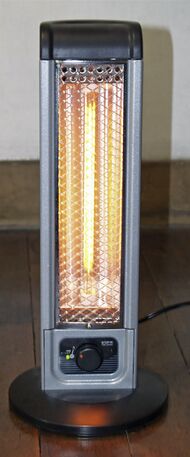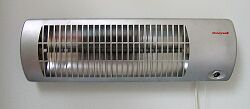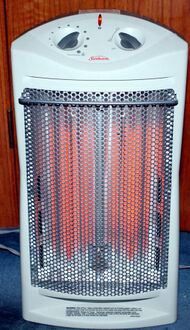Engineering:Space heater

A space heater is a device used to heat a single, small- to medium-sized area.[1] This type of heater can be contrasted with central heating, which distributes heat to multiple areas.
Operation
Electric space heaters fall into four main categories: fan heaters, ceramic, infrared, and oil-filled.[3]
- Fan heaters are the cheapest, but are often the least efficient and versatile. Nonetheless, they can be useful for heating small spaces, such as a small room or office cubicle.[3]
- Ceramic heaters push air across a piece of heated ceramic material. They can adequately heat a typical bedroom.[3]
- Infrared heaters provide more heat than ceramic models, and are also smaller and quieter. They do not oscillate like ceramic heaters, but consist of a heating chamber deep within the unit that prevents accidental fires, and allows for greater accumulation of heat before it is emitted by the unit. By the mid-2010s, many were outfitted with touch-screen controls and energy-saving settings, and were styled in such a way to complement the user's furniture. They grew in popularity in the 2010s.[3]
- Oil-filled heaters can silently heat larger rooms, but take longer to heat up. Like infrared models, they lack a fan, but circulate heat according to a room's air patterns, which is why it may take longer for a user to discern a difference in temperature. By the mid-2010s, some higher-end models included more precise controls.[3]
Without a fan
In convective heaters without a fan, the heating element is surrounded by oil or water. These heaters warm a room more slowly, because the liquid must be heated before the heat can reach the surrounding air. They produce more heat after being turned off, however, because of the hot liquid inside the heater. The risk of fire (and burns) is sometimes less with oil-filled heaters than those with fans,[4][5] but some fan-assisted heaters have a lower risk of fire (and burns) than other oil-filled heaters.[6]
Radiant heaters

Halogen heaters have tungsten filaments in sealed quartz envelopes, mounted in front of a metal reflector in a plastic case. They operate at a higher temperature than nichrome-wire heaters but not as high as incandescent light bulbs, radiating primarily in the infrared spectrum. They convert up to 86 percent of their input power to radiant energy, losing the remainder to conductive and convective heat.[7]
Safety
Fire, burns, and carbon monoxide poisoning are the main risks of space heaters. About 25,000 fires are caused by space heaters in the United States each year, resulting in about 300 deaths. Roughly 6,000 hospital emergency department visits annually in the US are caused by space heaters, mainly from burns.[8]
Operation
Improper use can increase the risk of fire and burns. Safe operation includes:[9][8][10]
- Plugging space heaters directly into a wall outlet and not an extension cord (except for heavy duty extension cords (14-gauge wire or larger) or relocatable power tap, as they can overheat and cause fires.
- Inspecting plugs and cords periodically for cracks or damage, and replacing them if needed.
- Keeping flammable materials, such as paper, plastics, curtains, furniture, and bedding, at least 3 feet (0.91 m) away from the heater.
- Turning off the heater when the last adult leaves the room or goes to sleep and keeping children and pets three feet away from the heater.
- Placing heaters on a flat, hard, nonflammable surface.
- Avoiding the use of heaters near flammable materials such as paint or gasoline.
- Installing smoke alarms and carbon monoxide detectors nearby.
Features
No one type of heater is safer than any other type. The risk of fire and burns can vary, depending on model and manufacturer.[6]
Certifications
In the United States, Underwriters Laboratories' UL 1278[11] (for portable electric space heaters) and UL 1042[12] standards (for portable and fixed baseboard electric heaters) certify heater safety. Although the General Services Administration had Specification W-H-193[13] for electric space heaters, it was replaced in 1995 by the UL standards. Additional information on portable-heater safety may be found at the Department of Energy's Energy Efficiency website.[14]
Legislation
New York City law regulates the safety of space heaters. Space heaters for sale in the city must have a thermostat to control temperature, an automatic shut-off feature if the heater tips over or overheats, and must be certified and labeled by a nationally approved organization or laboratory.[15]
Efficiency
The U.S. Environmental Protection Agency has evaluated a number of space heaters, but none have received its Energy Star label.[16]
See also
- Central heating
- District heating
- Electric heating
- Radiator
- Solar combisystem
References
- ↑ "the definition of space heater". http://dictionary.reference.com/browse/space%20heater.
- ↑ QBIC Heating. "What Are Oil-Filled Radiators?". https://www.qbicheating.co.uk/blog/what-are-oil-filled-radiators.html.
- ↑ 3.0 3.1 3.2 3.3 3.4 Tedeschi, Bob (2015-02-25). "Space Heater Reviews" (in en-US). The New York Times. ISSN 0362-4331. Archived from the original on February 27, 2015. https://web.archive.org/web/20150227075501/https://www.nytimes.com/2015/02/26/garden/space-heater-reviews.html.
- ↑ "Residential Energy Efficiency Space Heaters". Missouri Department of Natural Resources. http://www.dnr.mo.gov/energy/residential/spaceheaters.htm.
- ↑ New Fix-it-yourself Manual. Pleasantville, NY: The Reader's Digest Association. 2009. ISBN 978-0895778710. https://books.google.com/books?id=MvtUgEZ2rnsC.
- ↑ 6.0 6.1 "Space Heater Ratings". Consumer Reports. https://www.consumerreports.org/products/space-heater/ratings-overview/.
- ↑ 2008 ASHRAE Handbook – Heating, Ventilating, and Air-Conditioning Systems and Equipment (I-P Edition) American Society of Heating, Refrigerating and Air-Conditioning Engineers, Inc., 2008, Electronic ISBN:978-1-60119-795-5, table 2 page 15.3
- ↑ 8.0 8.1 "Portable Heaters". United States Department of Energy. https://energy.gov/energysaver/portable-heaters.
- ↑ "Why Space Heaters Need Their Space". Consumer Reports. https://www.consumerreports.org/space-heaters/space-heater-safety-tips/.
- ↑ "Space heaters involved in 79 percent of fatal home heating fires". National Fire Protection Agency. 2019-02-11. http://www.nfpa.org/News-and-Research/News-and-media/Press-Room/News-releases/2010/Space-heaters-involved-in-79-percent-of-fatal-home-heating-fires.
- ↑ Underwriters Laboratories (2000-06-21). "UL 1278, Standard for Movable and Wall- or Ceiling-Hung Electric Room Heaters". http://ulstandardsinfonet.ul.com/scopes/scopes.asp?fn=1278.html.
- ↑ Underwriters Laboratories (2009-08-31). "UL 1042, Electric Baseboard Heating Equipment". http://ulstandardsinfonet.ul.com/scopes/scopes.asp?fn=1042.html.
- ↑ General Services Administration (1977-09-13). "W-H-193D, Heater, Space, Electric (Portable)". https://assist.daps.dla.mil/quicksearch/basic_profile.cfm?ident_number=49036.
- ↑ Department of Energy (2011-02-09). "Portable Heaters". http://www.energysavers.gov/your_home/space_heating_cooling/index.cfm/mytopic=12600.
- ↑ "Electric Space Heater Sale Complaint". NYC 311. https://portal.311.nyc.gov/article/?kanumber=KA-03515#:~:text=In%20New%20York%20City%2C%20it,heater%20tips%20over%20or%20overheats. Retrieved 2023-09-24.
- ↑ Environmental Protection Agency. "Space Heaters". http://www.energystar.gov/index.cfm?c=heat_cool.pr_spaceheaters.
External links
 |



